Chandrahas Choudhury's Blog
November 25, 2024
The Darkness That Is Light
This essay appeared last weekend in The Peacock, the daily newspaper of the International Film Festival of India
Last December, I wandered down from Grant Road station in south Mumbai to Alfred Talkies, a senior citizen among Mumbai cinemas, a playhouse built in 1880 converted into a cinema in the 1930s. There, I found exactly the atmosphere that had once breathed light and life into the days and nights of my twenties. A few stragglers traipsed around in the lobby, which opened directly onto the bustling street. Inside his booth, the ticket clerk sat gazing down into his phone, beautifully framed by his own window, undisturbed by patrons, under a “Beware of Pickpockets” sign.
When the film ended, the door flew open, marshalled by an usher more used to shooing people out than welcoming them in. Out came a shabby and doleful parade. A man with one leg trussed up in bandages, a blue plastic bag dangling between crotch and crutch. Travellers with shoulder bags bulging with clothes, squat women with brightly painted lips, alcoholics blinking in the brightness.
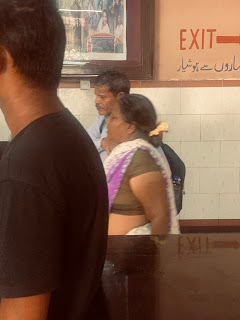 A blind couple stood next to me, holding hands – as romantic in their own way as Shahrukh Khan and Kajol. When we entered the bare and sad auditorium, with its metal seats and paanspit-stained concrete floors and whirring wall-mounted fans, they found a little nook for themselves and began to pass a vada-pav back and forth. Another woman walked past me and settled down in the best seat in the house – middle row, centre seat – and put her feet up, toes pointing away from each other like a dog’s ears.
A blind couple stood next to me, holding hands – as romantic in their own way as Shahrukh Khan and Kajol. When we entered the bare and sad auditorium, with its metal seats and paanspit-stained concrete floors and whirring wall-mounted fans, they found a little nook for themselves and began to pass a vada-pav back and forth. Another woman walked past me and settled down in the best seat in the house – middle row, centre seat – and put her feet up, toes pointing away from each other like a dog’s ears. I breathed deeply of the tubercular air, and as though by a wave of a wand, the hall suddenly split into zones of darkness and light. We were part of three intersecting worlds. That of the film, that of the cinema – and the small society of our own straggling selves, strangers and neighbours to one another in 12A, 16M, 21F.
Growing up in Bombay, I loved going to the cinema, but no more than millions of other Indians. Going to a theatre was thought slightly disreputable. The content itself was considered one hundred per cent corrupting. (When I got many answers wrong in an exam a day after pestering my father to take me to an Aamir Khan-Madhuri Dixit starrer in 1990, he hollered, “Next time, just write Dil! Dil! Dil! in your answer sheet!”) To tell you the truth, I myself preferred reading books, which allowed you to be a co-producer of images and speech and human faces in a story.
All that changed when my family moved to Delhi in 1998. Not only did the professors in my degree in English Literature make frequent allusions to film (usually films I’d never heard of), the newspapers often advertised film festivals and retrospectives, hosted by consulates and cultural centres. I started going to these shows in the evenings, sometimes doubling my pleasure by driving there in my mother’s newly bought blue Maruti 800.
Here was cinema with an astonishing diversity of narrative modes and styles: Kurosawa and Kieslowski, Tarkovsky and Ghatak, Kaurismaki and Majidi. The montage in these films seemed even more meaningful and alive than the sequences of sentences in the novels in my university course.
Very soon, my focus shifted entirely from books to films. When I won a scholarship to study English in Cambridge in 2000, I spent most afternoons of my first year at the Cambridge Arts Picturehouse, watching all the great new films of the world. After watching Shyam Benegal’s Manthan, I even dashed off a letter to the director, asking if I could come work with him. But all this was very naive (although sweet). As I would soon find out, I was just another cinephile maddened by the moving image, without a vision or theme or style or strategy.
Eventually, I returned to Bombay and began work as a cricket writer. Ill at ease with both life and work, I soon abandoned my job and set myself to a task I truly had some aptitude for: writing fiction. But who or what was I to write about? Mumbai was already the most written-up of Indian cities. Was there a path through the jungle?
One day, wandering around the city, I saw an old cinema hall playing a rerun, bought a ticket, and went in. From the moment that my hand, groping in the dark, found a hole in my seat, I was entranced. Here was a fascinating social universe, shabby and sometimes sordid, yet self-sufficient and serene. The rows of people in the audience had the familiar glazed expressions of cinemagoers worldwide. But their attention to the film was distracted and intermittent. Rather, they seemed rapt in some story or memory inside themselves.
In this segment of moviedom, the actual film was only one point of focus; it was the darkness that consoled and cocooned as much as the light amused and diverted. Hundreds of people came here each day to escape the harsh gaze of day – and now I was one of them. They needed a dark place to rest or ruminate, to pass time before a long-distance train journey, to arrange a rendezvous. (I suddenly remembered kissing my first girlfriend in the dark of Siri Fort Auditorium in Delhi, and thinking that the cinema was such a delightful place, for reasons that had nothing to do with film.)
If one were to be a film projectionist in such a cinema, of course one might be provoked by such a tasteless audience, seeking the cover of darkness and not the wonders released by a beam of light arrowing down from above. But equally, one might see oneself as a sort of good shepherd of lost sheep. A master of ceremonies supplying the light that helped the immense darkness sustain itself against the predatory landgrabbers of the cosmopolis, and keep up its heritage as a shaam-iana for lost souls.
 From this insight came the story for my first novel, Arzee the Dwarf, about a very small man who works as a projectionist in an old cinema in Bombay, the Noor (“light” in Urdu). Arzee loves the Noor, but not just with the passion of a cinephile (which he is). Rather, the darkness of the cinema is a very specific gift to his own stunted body. In lighted spaces and on the street, he is continually exposed to ridicule, but in the dark, he becomes invisible and then his real qualities shine through.
From this insight came the story for my first novel, Arzee the Dwarf, about a very small man who works as a projectionist in an old cinema in Bombay, the Noor (“light” in Urdu). Arzee loves the Noor, but not just with the passion of a cinephile (which he is). Rather, the darkness of the cinema is a very specific gift to his own stunted body. In lighted spaces and on the street, he is continually exposed to ridicule, but in the dark, he becomes invisible and then his real qualities shine through. Further, the projectionist always works on the top floor of the cinema. From his projection booth, Arzee looks down at the world, as a king might from his castle, and cannot be looked down on. The cinema is like his second body, lifting him up into the heavens. Arzee is a custodian and benefactor of both light and darkness, and this is his black-and-white gift to the people of Mumbai – at least all those who will come to his door and settle in his cinematic dawaakhana, “still and intent as statues”.
 This week, at IFFI, I see once again scores of people who have travelled long distances from Goa in search of great cinema, but also harbouring a deep faith in the cinematic space itself, a conviction that the moving image is most beautiful (and moving) when projected to the largest possible size and savoured in a great dark cavern in the company of hundreds of other cinephiles. Watching a Netflix show at home, we consume cinema in solitude or with those whom we already know well (even sometimes responding to WhatsApp messages on the side). But there is something about the ah-h-h of four hundred people catching their breath at the same time or the ripple of laughter pulsing across a room, like a wind through wheatfields, that reminds us of our shared humanity, our common emotional triggers and taste.
This week, at IFFI, I see once again scores of people who have travelled long distances from Goa in search of great cinema, but also harbouring a deep faith in the cinematic space itself, a conviction that the moving image is most beautiful (and moving) when projected to the largest possible size and savoured in a great dark cavern in the company of hundreds of other cinephiles. Watching a Netflix show at home, we consume cinema in solitude or with those whom we already know well (even sometimes responding to WhatsApp messages on the side). But there is something about the ah-h-h of four hundred people catching their breath at the same time or the ripple of laughter pulsing across a room, like a wind through wheatfields, that reminds us of our shared humanity, our common emotional triggers and taste. We are bright-eyed and fully alive in the dark, yet we lose our faces; we give them away to be part of a story-streaming commune for two or three hours. “IFFI is not just a celebration of filmmaking, it is also a celebration of the audience,” said IFFI’s director Shekhar Kapur to me earlier this week. We come together several times each day under that mantle of darkness – the enchanted dark that we know, like Arzee, to be a kind of light.
August 25, 2024
On Sopan Joshi's Mangifera Indica
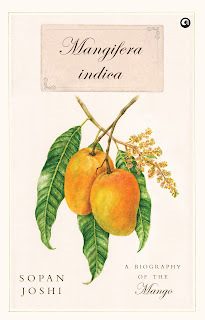 This year, for the first time, the mango became something more than a very exciting and consoling and sensuous gustatory experience for me—such that I almost ceased to regard it as an object of consumption.
This year, for the first time, the mango became something more than a very exciting and consoling and sensuous gustatory experience for me—such that I almost ceased to regard it as an object of consumption.My teacher was a mango tree, planted in the 1980s in the small yard outside the house that my parents built in Bhubaneswar. Over the years I had come and gone many times without ever paying much heed to the parallel universe that it had created and sustained within its boughs. But now that I had a small library on the rooftop, every morning began with a few minutes within its aura, somehow both serene and ecstatic.I took to reading with its long green leaves gently rustling in the wind: fine music for the mornings. In January, thousands of small green flowers, packed into conical panicles, burgeoned on its branches. Slowly, their stalks turned a sindoori red—the colour of creativity and passion, revealing just why Kama is said to choose mango flowers for his arrows. Squirrels, birds, chameleons, bees,ants, and spiders buzzed within its canopy, a small society of ardent arboreals.
When I plucked a tiny subsection of flowers and pressed down on it with my fingernail, the ethereal tart fragrance of kachchi kairi rose to my nose. A few weeks later, tiny green fruit began to appear on the stalks. Whenever I left for a few days and returned, they had plumped out a bit more, dangling in small clusters, fed by fragrant sap running up from roots 70ft away.
 Slowly they began to ripen. Their sun-facing sides turned yellow first: a daily demonstration of how heat and light from a faraway star metamorphose into life and colour and taste here on earth. In April and May, after three months of fruition, they became ripe and began to fall all around the house, to the great delight of passers-by. Their heads and shoulders were stained by sap. I only ate a few. I didn’t want to. Watery and much less complex than the best mango varietals, they had nevertheless proved to be a revelation of all the wonders of life.
Slowly they began to ripen. Their sun-facing sides turned yellow first: a daily demonstration of how heat and light from a faraway star metamorphose into life and colour and taste here on earth. In April and May, after three months of fruition, they became ripe and began to fall all around the house, to the great delight of passers-by. Their heads and shoulders were stained by sap. I only ate a few. I didn’t want to. Watery and much less complex than the best mango varietals, they had nevertheless proved to be a revelation of all the wonders of life.Perhaps the only way to make the entire cycle more mangivorous would have been to spend those mornings reading Mangifera Indica , Sopan Joshi’s exuberant and magisterial survey of the influence of the mangoover Indian life and thought. Joshi’s basic thesis, which he illustrates with infectious verve and detail, is that to us subcontinentals, the mango is much more than a fruit, it is an entire culture: a path back to childhood, an emblem of longing and desire and ecstasy, a non-verbal code of civilisation and culture, a roadway into myth and history.
Despite being so deeply embedded in our imaginations for millennia here is something mysterious and elusive about the mango. For instance, there is the unpredictable way in which it propagates.Mangoes grown from seed, or beeji mangoes, are very rarely “true to type”—the seed of a gulab khas or imam pasand does not yield a tree that has the same kind of fruit—and need the aid of “kalmi” or grafting for mass-scale production for a consumer base as large as India’s. Again, there is the frequent disjunction between looks and taste: many of the best varietals are nondescript to the eye. There is a sense of insufficiency associated with mangoes, even when we can eat as many as we like. India is too big a country and the fruit too mercurial a personality for it to travel to distant markets. There will always be more varietals that we haven’t tasted than those that we have.
Among the lovely details that Joshi offers is that just like Indians themselves, south Indian varietals often do well when transplanted to the north, but the reverse is rarely true. Joshi sprinkles many such charming facts and references along his rambling journey (he drives a Harley Davidson to many far-flung mango orchards). In the seventh century CE, the Chinese traveller Hsuan Tsang travelled to Sarnath, where he mentions visiting a large vihara with a golden figure of a mango above the roof. “Buddha’s concerns were universal and existential,” glosses Joshi. “He needed the kind of metaphors that turn abstract ideas into imaginable forms.” In Jharkhand’s Chaibasa, Joshi meets Kunwar Singh Janko, a tribal in search of the land holdings of his ancestors in the sal forest. Two ways of identifying such lands are tombstones and old mango trees.
Even Gandhi, who resisted the call of sensuality and temptation all his mature life, struggled to eliminate mangoes from his diet. “We must get used to not treating it with so much affection,” he writes sternly in a letter from 1941. Mirza Ghalib would never have agreed. More than 35 kinds of mango are cited in his own letters.
The mango also has an extensive literature of its own. Much of it is throwaway journalism; another large part comprises highly technical and dry scientific papers. So it’s worth focusing on where Joshi breaks new ground. Most writers on the mango (myself included) have only situated the mango within a human-centric history of taste; Joshi opens out the frame to locate it within a history of life itself.“The influence of fruit (on life) is very deep,” he writes, as he shows how plants and animals and human beings have co-evolved over tens of thousands of years.
In this view of things, primates (the genus of living creatures which includes apes and human beings) developed colour vision to find the brightly coloured fruits of the tropical rainforest, the seeds of which in turn we dispersed far and wide—sometimes across entire continents. (On my first morning in Brazil a few years ago, I came across a mango lying broken open on a stone pathway on the island of Itaparica. I picked it up and it smelled like no mango that had ever come my way—it had become Brazilian.)
“We do not like to see ourselves as primates shaped by fruiting trees,” Joshi writes. We would rather believe today that it is we humans who have shaped and ordered the world of the mango. But the long-historical record proves otherwise. “It was the plants that began hitting on animals,” Joshi writes—a fact we still acknowledge when we raise a mango to our noses to detect whether it is ripe. Thinking about mangoes in the widest possible frame requires that we “lift ourselves out of human solipsism and join biology’s dance to the music of deep time.” At moments like this Joshi’s writing approaches the ecstatic tremors found in the work of Stephen Jay Gould, David Quammen and Timothy Ferris.
The other noteworthy aspect of Joshi’s book is his insightful survey, based on extensive legwork and discussions with mango growers and traders (whom he allows to speak in their own voice), of the problems that plague the Indian mango industry. Most mango orchards in India, he notes, are not tended by their owners; many were acquired in the years after independence as a way of evading the strictures of the Land Ceiling Act. Today they are given out on contract, but an indifferent landlord never made for productive and well-tended land. In contrast, the passion and sense of purpose and awareness of tradition found in the best mango-growers is truly life-affirming.
It is always a big claim to say of a book that it will still be read in a hundred years. But it is hard to imagine that there will ever be a better literary companion to the mango than Mangifera Indica.
This essay appeared recently in Mint Lounge.
March 25, 2024
Understanding The Mind of the Young Indian Voter
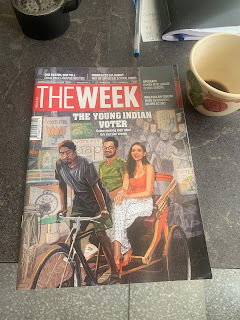
"Understanding The Mind of the Young Indian Voter."
This cover story written by myself appears this week as the cover story in The Week. It is accompanied by a long interview with Anwesh Satpathy, 20.
My essay "Understanding The Mind of the Young Indian Vote...

My essay "Understanding The Mind of the Young Indian Voter" appears this week as the cover story in The Week. It is accompanied by a long interview with Anwesh Satpathy, 20.
January 19, 2024
Travels in the Year of the Ram Mandir
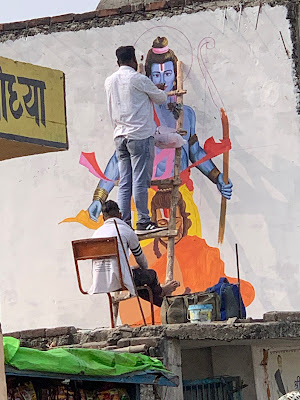 "Jai Shri Ram!" All day long, the cry surfaces and reverberates in Ayodhya. It is the rallying call of the public along the wide walkway leading from the main road to the Ram Janambhoomi temple complex, hazy with construction dust and lined by workers with electric drills installing large pink concrete panels to screen off the mottled facades of the decrepit buildings on either side. It erupts with particular intensity among the shoals of devotees as they jostle on the narrow steps leading up to the Hanuman Garhi temple. It is spoken more gently after the moving morning aarti, offered to statues of Ram and Sita swaying gently on a swing, in the courtyard of the hundred-year-old Amava Ram temple with its crest of a giant bow -- and inside, its own glass-walled shrine to Ram Lalla, installed in the immediate wake of the Supreme Court judgment of 2019 -- where people gather in long rows at lunchtime a generous lunch of rice, dal, pooris and sabji provided for free by the temple's Ram Rasoi.
"Jai Shri Ram!" All day long, the cry surfaces and reverberates in Ayodhya. It is the rallying call of the public along the wide walkway leading from the main road to the Ram Janambhoomi temple complex, hazy with construction dust and lined by workers with electric drills installing large pink concrete panels to screen off the mottled facades of the decrepit buildings on either side. It erupts with particular intensity among the shoals of devotees as they jostle on the narrow steps leading up to the Hanuman Garhi temple. It is spoken more gently after the moving morning aarti, offered to statues of Ram and Sita swaying gently on a swing, in the courtyard of the hundred-year-old Amava Ram temple with its crest of a giant bow -- and inside, its own glass-walled shrine to Ram Lalla, installed in the immediate wake of the Supreme Court judgment of 2019 -- where people gather in long rows at lunchtime a generous lunch of rice, dal, pooris and sabji provided for free by the temple's Ram Rasoi. And even closer to the new Ram Mandir, it sounds thrice a day inside the small temporary shrine for Ram Lalla set up in 2020, approached through a winding barred corridor after multiple security checks, after the aartis of morning, afternoon and evening to which only 30 people are admitted by a very democratic first-come-first-served system. When after several attempts I manage to land an aarti pass, several family members send me WhatsApp messages of congratulation.
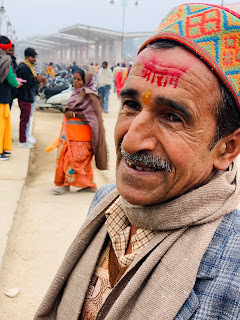 Many people on the streets, and almost all those walking on the Ram Janambhoomi Path to gaze at the new temple complex from afar, have the words "Shri Ram" or "Sitaram" stencilled on their foreheads in red on a base of yellow. This is the one mark of uniformity connecting a thrillingljy diverse array of tongues -- Hindi, Avadhi and Bhojpuri; Marathi and Gujarati; Telugu and Tamil -- dressing styles, and faces on Ram Janambhoomi Path. A substantial share of them are the weathered, statuesque faces of old India -- people who seem to have dipped their feet only lightly in the waters of modernity, and appear to possess a correspondingly large store of psychic space for the adoration of Ram and the moral universe of the Ramayana.
Many people on the streets, and almost all those walking on the Ram Janambhoomi Path to gaze at the new temple complex from afar, have the words "Shri Ram" or "Sitaram" stencilled on their foreheads in red on a base of yellow. This is the one mark of uniformity connecting a thrillingljy diverse array of tongues -- Hindi, Avadhi and Bhojpuri; Marathi and Gujarati; Telugu and Tamil -- dressing styles, and faces on Ram Janambhoomi Path. A substantial share of them are the weathered, statuesque faces of old India -- people who seem to have dipped their feet only lightly in the waters of modernity, and appear to possess a correspondingly large store of psychic space for the adoration of Ram and the moral universe of the Ramayana. The traveller looks at the faces around him and thinks: our paths will likely never cross again. When a boy comes running up and offers to stencil Ram on my forehead for 10 rupees, I do not refuse the badge of the moment. The stencils are themselves part of a giant new economy of Ram paraphernalia flooding the puja samagri shops of the city: wooden replicas of the new Ram Mandir, Jai Shri Ram plaques, Jai Shri Ram ballpoint pens, Jai Shri Ram car dashboard standees, Hanuman maces, Jai Shri Ram pennants, and Jai Shri Ram charan padukas.
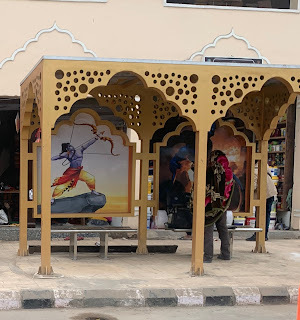 All temple towns have two orders of reality: the shabby and clamorous world of the lok, and the ethereal and consoling universe of the dev lok. Ayodhya feels like it has three: the newest layer resembles a film set of an unsubtle blockbuster. The shutters of shops for several kilometres on the road from Faizabad to Mangeshkar Chowk are now painted with saffron trishuls, maces, and bows. New bus shelters broadcast pictures of Ram about to let fly an arrow. On the ghats of Ram ki Paidi can be heard the belligerent beat of Hindutva pop (including the hit "Yeh Rama Lalla Ka Dera Hai" by Shahnaaz Akhtar) blaring from loudspeakers to go with the traditional bhajans and kirtans. And there are locals kitted out as Ram, Lakshman and Sita by TV channels keen to provide a dash of theatre to their debate stages.
All temple towns have two orders of reality: the shabby and clamorous world of the lok, and the ethereal and consoling universe of the dev lok. Ayodhya feels like it has three: the newest layer resembles a film set of an unsubtle blockbuster. The shutters of shops for several kilometres on the road from Faizabad to Mangeshkar Chowk are now painted with saffron trishuls, maces, and bows. New bus shelters broadcast pictures of Ram about to let fly an arrow. On the ghats of Ram ki Paidi can be heard the belligerent beat of Hindutva pop (including the hit "Yeh Rama Lalla Ka Dera Hai" by Shahnaaz Akhtar) blaring from loudspeakers to go with the traditional bhajans and kirtans. And there are locals kitted out as Ram, Lakshman and Sita by TV channels keen to provide a dash of theatre to their debate stages.Under the grey winter skies of January, then, Ayodhya -- already steeped in the language and lore of Ram -- awaits its tryst with destiny. Will the city be able to bear the weight of aspirations suddenly invested in it? After all, almost overnight the actual residents of Ayodhya are fated to become a minority in their own city. Millions of Indians and NRIs, not to mention the ruling party and most of the mass media, are avid to transform themselves into Ayodhyavasis, as perhaps they were not to become the self-ruling, difference-cherishing people of a republic, reminded by Gandhi (always such a pressuring soul, and especially towards Hindus) that real ramrajya begins within oneself, that it requires great introspection and the abjuring of violence.
That privilege, that legacy -- which for decades seemed a great gift -- now seems banal when compared to the chance to be the fervid, righteous praja of a new state and a new epoch, the fortunate generation chosen by Lord Ram to restore order and purity, a single source of authority, to a mongrel millennium.
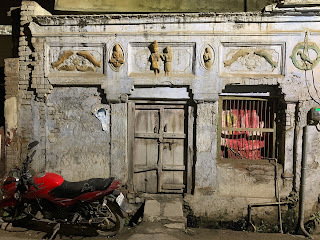 Amidst the hail of Jai Shri Rams! in Ayodhya, one hears the murmur of the mild-mannered old town saying goodbye to itself. Its destiny is to be the beacon of a renaissance: to make India Hindu again, epic again.
Amidst the hail of Jai Shri Rams! in Ayodhya, one hears the murmur of the mild-mannered old town saying goodbye to itself. Its destiny is to be the beacon of a renaissance: to make India Hindu again, epic again.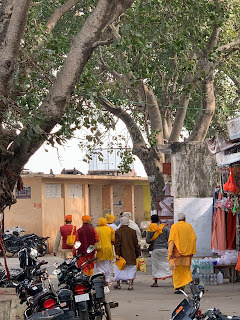 “Bahut kasht hua hamarey sarkar ko”
“Bahut kasht hua hamarey sarkar ko”
On the banks of the Saryu, I come across a group of sadhus clad in shades of saffron, ochre and white, marching from the main road towards the river in a file, like ants on a trail, to take a boat ride. Unlike the local sants of Ayodhya -- many of whom, like Mahant Raju Das of Hanuman Garhi, spew insult and innuendo and espouse a Manichaean worldview in which all who are not for (their) Ram are against Ram -- this lot have the light-hearted and bantering manner of guests at a wedding out on a bit of sightseeing.
And indeed that is who they are. They belong to a contingent of more than a thousand sadhus just arrived from Janakpur dham in Nepal, "jahan Sita mata ka janambhoomi hai," emissaries from "Ramji ka sasuraal," bearing truckloads of gifts from the kingdom of Mithila to celebrate the return of their king to his birthplace. What have they brought? "Gehna zevar, sona chandi, bartan bhara, chaul-daal, chappan-sattavan rang ke mithai" and, with a delightful touch of anachronism, even gas stoves.
The events of the Ramayana may be from another epoch, but to most in Ayodhya they are not remote. The trails of Ram, Lakshman and Sita are still imprinted everywhere in the geography of Uttar Pradesh, Madhya Pradesh, and Nepal, and are part of a luminous and eternal present of a different dimension from the mundane past, present and future of the human soul sojourning briefly in this world in the body and on the river of history. With the men from Janakpur, as with so many others I meet, the Ramayana is the foundation and frame of reality; the life of this world merely a state of reflected light, as the moon to the sun.
Our paths seem, paradoxically, to intersect at the same moment in history without us being part of the same age; this is the intractable jumble of samay and kaal that the post-independence Indian state, itself the product of a certain historical conjuncture and committed to contemplating time in secular terms, has found so difficult to accommodate and harmonise without capsizing under the current of cosmic time. To their way of thinking, both archaic and arresting, the world of men and women in society and history was once and forever aligned by Ram, with Ram, and was then cruelly uprooted. As the family members of Sita, they feel the feel the pain of their brother-in-law, exiled from his birthplace not for 14 years but five long and dark centuries.
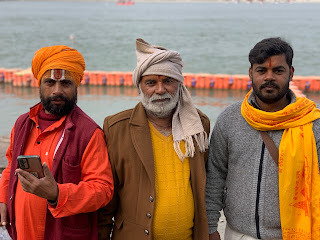 "Bahut kasht hua hamarey sarkar ko! Panch sau barees...panch sau barees kasht kiye," exclaims Deen Dayal Saran, 62, barrel-chested, bearded, tilaked, turbaned, missing two front teeth, and all in all as charming a litigant as one could imagine. Very quaintly, Saran insists that Janakpur has an even deeper relationship to Ram now than ever before, because, being deprived of his own kingdom, "Ramji toh Janakpur mein hi reh gaye." He may have long been a resident of Janakpur, but seen the indelible contours of lineage, family, and marriage in Hindu thought he was nevertheless always first and foremost a visiting son-in-law, a "pahunwa."
"Bahut kasht hua hamarey sarkar ko! Panch sau barees...panch sau barees kasht kiye," exclaims Deen Dayal Saran, 62, barrel-chested, bearded, tilaked, turbaned, missing two front teeth, and all in all as charming a litigant as one could imagine. Very quaintly, Saran insists that Janakpur has an even deeper relationship to Ram now than ever before, because, being deprived of his own kingdom, "Ramji toh Janakpur mein hi reh gaye." He may have long been a resident of Janakpur, but seen the indelible contours of lineage, family, and marriage in Hindu thought he was nevertheless always first and foremost a visiting son-in-law, a "pahunwa."To these men, as to millions of Indians, the new Ram temple represents the undoing of a traumatic rupture. The architects of this redemption are very clear. “Ashirbaad dete hain Yogiji aur Modiji ko ke aaj hamari behen Sita apne ghar mein padhaar rahein hain. Kot kot hriday se dhanyavaad de rahey hain."
Thankfully, their manner is triumphant without being gloating; they seek the return of a lost utopia, but are without the hubris, partly encouraged by the moral schema of the Ramayana itself, of those who would believe that good is all on their own side and evil is entirely outside there somewhere. For now, it is a time to shower praise on the entire universe, to create a mood of mischief and laughter, singing and taking videos of one another, as one would at a wedding.
As we float down the river in the company of the boatman and a life-size pink teddy bear (every boat in Ayodhya seems to have a cuddly toy), every man produces a new item for the litany:
"Sarju Mata ki...!""Jai!"“Janakpur dham ki...!”“Jai!”“Janaki Maharani ki...!”“Jai!”“Janak ke jamai ki...!”“Jai!”“Ramji ke babu ki...!”“Jai!”"Ramji ki bahin ki..." (laughter)"Jai!"
Heard in Ayodhya and Varanasi in the first half of January
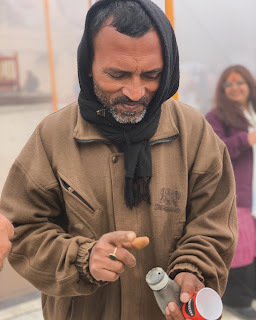 "Pachas saal angreji saasan mein kuch bhi nahin kiya. Aur oo! Dus saal rahkar bhi kitna kuch kar diya."
"Pachas saal angreji saasan mein kuch bhi nahin kiya. Aur oo! Dus saal rahkar bhi kitna kuch kar diya."
An RSS worker and a seller of nimboo chai on the ghats of Banaras, of Prime Minister Modi
"If you do not accept the ideology of Hindutva today, you are immediately seen as being the product of a colonial mindset."
Young journalist from Delhi, at a cafe in Ayodhya
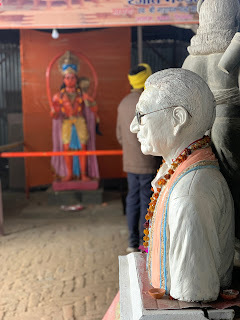 "The credit for bringing the Ram Mandir project to fruition rests with only three people. First, Ashokji Singhal. Second, Narendra Modi. And third, Narendra Modi. Of course, the credit for awakening the Hindus and turning the Mandir movement into a mass cause goes to LK Advani. But Advani was not prepared to embrace the consequences of his own rath yatra. Advani and Vajpayee were both cowards. They could not take the matter the whole distance despite coming to power. For daring to do that, the credit goes to Modi."
"The credit for bringing the Ram Mandir project to fruition rests with only three people. First, Ashokji Singhal. Second, Narendra Modi. And third, Narendra Modi. Of course, the credit for awakening the Hindus and turning the Mandir movement into a mass cause goes to LK Advani. But Advani was not prepared to embrace the consequences of his own rath yatra. Advani and Vajpayee were both cowards. They could not take the matter the whole distance despite coming to power. For daring to do that, the credit goes to Modi."Retired professor, Varanasi
"Even after gaining access to education, the people of India did not learn to think logically. They remained highly emotional. So we could not become a real democracy. We remained only a representative democracy."
A schoolteacher, Ayodhya
"More and more people are coming to my shop these days asking for history books about India. But of the right kind -- not the leftist or Romila Thapar kind of Indian history."
Rakesh Singh, owner of Harmony Bookshop, Varanasi
"Papa! Bachava! Bandar ghoom rahey hain."
Young boy, Ram ki Paidi, Ayodhya
"Ram ki kripa toh Bhajpa pe hai"
Every teashop and street corner in Ayodhya hums with debates about the meaning of the coming moment. The historical frames and causal joints of the discussions wax and wane with tremendous speed: 2019, 1992, 1984, 1949, 1528. It is thought eminently reasonable to assert a direct line between the Treta Yuga and the 22nd of January 2024. To be incarnated in such a hoary old civilization is never to be in agreement about the meaning of time -- or about being on time.
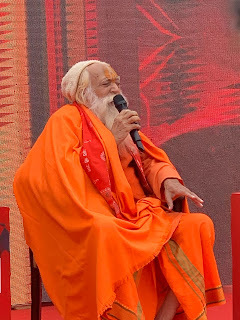 For a few days from January 10 onwards, the burning theme of town tea-talk is the decision by the Congress Party to reject the invitation to attend the pran prathisthana ceremony of the Ram mandir. This is projected by much of the media, following the lead of the ruling party, not a decision to maintain a boundary between religion and politics, but a political stunt in its own right. In a discussion hosted by a news channel at the Ram ki Paidi ghat on 12 January, Acharya Satyendra Das, the head priest of the Ram Mandir, is asked what he makes of this matter. "Unhoney nimantran nahin thukraya...Bhagwan Ram ne hi unko thukra diya hai," he replies. "Aur is liye woh sadak par ghoom rahey hain." He quotes from the Aranyakanda: "'Jaapar kripa Ram ki hoi/Taapar kripa karey sab koi.' Ram ki kripa toh Bhajpa pe hai, jis se woh satta mein hain."
For a few days from January 10 onwards, the burning theme of town tea-talk is the decision by the Congress Party to reject the invitation to attend the pran prathisthana ceremony of the Ram mandir. This is projected by much of the media, following the lead of the ruling party, not a decision to maintain a boundary between religion and politics, but a political stunt in its own right. In a discussion hosted by a news channel at the Ram ki Paidi ghat on 12 January, Acharya Satyendra Das, the head priest of the Ram Mandir, is asked what he makes of this matter. "Unhoney nimantran nahin thukraya...Bhagwan Ram ne hi unko thukra diya hai," he replies. "Aur is liye woh sadak par ghoom rahey hain." He quotes from the Aranyakanda: "'Jaapar kripa Ram ki hoi/Taapar kripa karey sab koi.' Ram ki kripa toh Bhajpa pe hai, jis se woh satta mein hain.""The Congress did not reject the invitation. Lord Ram himself rejected the Congress. Ram's blessing is for the BJP, which is why they are in power today, and the Congress on the streets." In this genre of opinion (cheered on by the inevitable chants of Jai Shri Ram), we hear the totalizing logic injected into the bloodstream of Indian democracy and the public sphere by the Ram Mandir movement and its votaries, and asserted with ever greater audacity as it swells in power and numbers.
Travels in India in the Year of the Ram Mandir
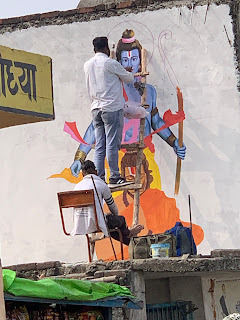 "Jai Shri Ram!" All day long, the cry surfaces and reverberates in Ayodhya. It is the rallying call of the public along the wide walkway leading from the main road to the Ram Janambhoomi temple complex, hazy with construction dust and lined by workers with electric drills installing large pink concrete panels to screen off the mottled facades of the decrepit buildings on either side. It erupts with particular intensity among the shoals of devotees as they jostle on the narrow steps leading up to the Hanuman Garhi temple. It is spoken more gently after the moving morning aarti, offered to statues of Ram and Sita swaying gently on a swing, in the courtyard of the hundred-year-old Amava Ram temple with its crest of a giant bow -- and inside, its own glass-walled shrine to Ram Lalla, installed in the immediate wake of the Supreme Court judgment of 2019 -- where people gather in long rows at lunchtime a generous lunch of rice, dal, pooris and sabji provided for free by the temple's Ram Rasoi.
"Jai Shri Ram!" All day long, the cry surfaces and reverberates in Ayodhya. It is the rallying call of the public along the wide walkway leading from the main road to the Ram Janambhoomi temple complex, hazy with construction dust and lined by workers with electric drills installing large pink concrete panels to screen off the mottled facades of the decrepit buildings on either side. It erupts with particular intensity among the shoals of devotees as they jostle on the narrow steps leading up to the Hanuman Garhi temple. It is spoken more gently after the moving morning aarti, offered to statues of Ram and Sita swaying gently on a swing, in the courtyard of the hundred-year-old Amava Ram temple with its crest of a giant bow -- and inside, its own glass-walled shrine to Ram Lalla, installed in the immediate wake of the Supreme Court judgment of 2019 -- where people gather in long rows at lunchtime a generous lunch of rice, dal, pooris and sabji provided for free by the temple's Ram Rasoi. And even closer to the new Ram Mandir, it sounds thrice a day inside the small temporary shrine for Ram Lalla set up in 2020, approached through a winding barred corridor after multiple security checks, after the aartis of morning, afternoon and evening to which only 30 people are admitted by a very democratic first-come-first-served system. When after several attempts I manage to land an aarti pass, several family members send me WhatsApp messages of congratulation.
 Many people on the streets, and almost all those walking on the Ram Janambhoomi Path to gaze at the new temple complex from afar, have the words "Shri Ram" or "Sitaram" stencilled on their foreheads in red on a base of yellow. This is the one mark of uniformity connecting a thrillingly diverse array of tongues -- Hindi, Avadhi and Bhojpuri; Marathi and Gujarati; Telugu and Tamil -- dressing styles, and faces on Ram Janambhoomi Path. A substantial share of them are the weathered, statuesque faces of old India -- people who seem to have dipped their feet only lightly in the waters of modernity, and appear to possess a correspondingly large store of psychic space for the adoration of Ram and the moral universe of the Ramayana.
Many people on the streets, and almost all those walking on the Ram Janambhoomi Path to gaze at the new temple complex from afar, have the words "Shri Ram" or "Sitaram" stencilled on their foreheads in red on a base of yellow. This is the one mark of uniformity connecting a thrillingly diverse array of tongues -- Hindi, Avadhi and Bhojpuri; Marathi and Gujarati; Telugu and Tamil -- dressing styles, and faces on Ram Janambhoomi Path. A substantial share of them are the weathered, statuesque faces of old India -- people who seem to have dipped their feet only lightly in the waters of modernity, and appear to possess a correspondingly large store of psychic space for the adoration of Ram and the moral universe of the Ramayana. The traveller looks at the faces around him and thinks: our paths will likely never cross again. When a boy comes running up and offers to stencil Ram on my forehead for 10 rupees, I do not refuse the badge of the moment. The stencils are themselves part of a giant new economy of Ram paraphernalia flooding the puja samagri shops of the city: wooden replicas of the new Ram Mandir, Jai Shri Ram plaques, Jai Shri Ram ballpoint pens, Jai Shri Ram car dashboard standees, Hanuman maces, Jai Shri Ram pennants, and Jai Shri Ram charan padukas.
 All temple towns have two orders of reality: the shabby and clamorous world of the lok, and the ethereal and consoling universe of the dev lok. Ayodhya feels like it has three: the newest layer resembles a film set of an unsubtle blockbuster. The shutters of shops for several kilometres on the road from Faizabad to Mangeshkar Chowk are now painted with saffron trishuls, maces, and bows. New bus shelters broadcast pictures of Ram about to let fly an arrow. On the ghats of Ram ki Paidi can be heard the belligerent beat of Hindutva pop (including the hit "Yeh Rama Lalla Ka Dera Hai" by Shahnaaz Akhtar) blaring from loudspeakers to go with the traditional bhajans and kirtans. And there are locals kitted out as Ram, Lakshmana and Sita by TV channels keen to provide a dash of theatre to their debate stages.
All temple towns have two orders of reality: the shabby and clamorous world of the lok, and the ethereal and consoling universe of the dev lok. Ayodhya feels like it has three: the newest layer resembles a film set of an unsubtle blockbuster. The shutters of shops for several kilometres on the road from Faizabad to Mangeshkar Chowk are now painted with saffron trishuls, maces, and bows. New bus shelters broadcast pictures of Ram about to let fly an arrow. On the ghats of Ram ki Paidi can be heard the belligerent beat of Hindutva pop (including the hit "Yeh Rama Lalla Ka Dera Hai" by Shahnaaz Akhtar) blaring from loudspeakers to go with the traditional bhajans and kirtans. And there are locals kitted out as Ram, Lakshmana and Sita by TV channels keen to provide a dash of theatre to their debate stages.Under the grey winter skies of January, then, Ayodhya -- already steeped in the language and lore of Ram -- awaits its tryst with destiny. Will the city be able to bear the weight of aspirations suddenly invested in it? After all, almost overnight the actual residents of Ayodhya are fated to become a minority in their own city. Millions of Indians and NRIs, not to mention the ruling party and most of the mass media, are avid to transform themselves into Ayodhyavasis, as perhaps they were not to become the self-ruling, difference-cherishing people of a republic, reminded by Gandhi (always such a pressuring soul, and especially towards Hindus) that real ramrajya begins within oneself, that it requires great introspection and the abjuring of violence.
That privilege, that legacy -- which for decades seemed a great gift -- now seems banal when compared to the chance to be the fervid, righteous praja of a new state and a new epoch, the fortunate generation chosen by Lord Ram to restore order and purity, a single source of authority, to a mongrel millennium.
 Amidst the hail of Jai Shri Rams! in Ayodhya, one hears the murmur of the mild-mannered old town saying goodbye to itself. Its destiny is to be the beacon of a renaissance: to make India Hindu and epic again.
Amidst the hail of Jai Shri Rams! in Ayodhya, one hears the murmur of the mild-mannered old town saying goodbye to itself. Its destiny is to be the beacon of a renaissance: to make India Hindu and epic again.
January 17, 2024
Kabir and his Rama
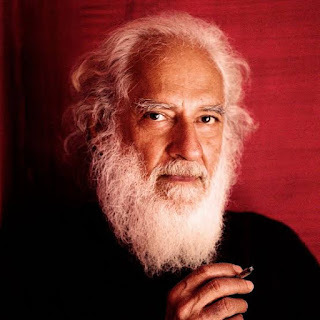 The poet Kabir deserves to be counted alongside Rumi and Julian of Norwich as one of the greatest mystics of the last millennium. From the fifteenth century onward, his Hindustani-language poetry has resonated across north India, where verses and phrases from the corpus of poems attributed to him are known to just about everybody. Kabir’s power derives from a syncretic, independent-minded reading of God and religion, particularly Hinduism and Islam, that is not only compelling on its own terms but has proved ideologically useful for modern liberal projects like the secular Indian republic. That power can best be experienced in a slim book of translations by the Indian poet Arvind Krishna Mehrotra.
The poet Kabir deserves to be counted alongside Rumi and Julian of Norwich as one of the greatest mystics of the last millennium. From the fifteenth century onward, his Hindustani-language poetry has resonated across north India, where verses and phrases from the corpus of poems attributed to him are known to just about everybody. Kabir’s power derives from a syncretic, independent-minded reading of God and religion, particularly Hinduism and Islam, that is not only compelling on its own terms but has proved ideologically useful for modern liberal projects like the secular Indian republic. That power can best be experienced in a slim book of translations by the Indian poet Arvind Krishna Mehrotra.Kabir was a low-caste Muslim weaver who was born and lived all his life in the holy city and bustling metropolis of Banaras (now Varanasi). He stands in Indian literary history at the center of an enduring religious and philosophical movement called bhakti, which stresses transcendent spiritual devotion without distracting rituals and doctrine.
Many translations of his work into English exist, from the slightly orotund, Victorian versions composed by the Bengali Nobel poet-laureate Rabindranath Tagore in the early 20th century to the Americanized versions in the 1980s produced by the poet Robert Bly. But Kabir’s famed iconoclasm, speed of thought, slashing paradoxical style, metaphorical zest and rhetorical brilliance have rarely been rendered into English better than in Mehrotra’s versions.
Kabir is that rare thing: a skeptical, disillusioned poet who nevertheless speaks in a voice of rapture and entrancement. His work can be situated within a long tradition of Hindu thought that asks penetrating questions about the nature of perception, and insists that what we think we know through our senses about the nature of reality is merely maya or illusion. Or, as he says in a poem not included in this collection, “The knowledge that knows what knowledge is:/ That’s the knowledge that’s mine.”
Here is one of his sallies upon the subject in Mehrotra’s brief, bleak and astringent rendition:The mind’s “wife” here is the body, the “scoundrel children” the five senses. Mehrotra’s cunning deployment of enjambment—the breaking of a phrase or sentence across a poetic line—propels us from one line to the next, re-enacting, in the four-line opening sentence, the way the mind pieces together the meaning of the world from the messages of the senses, before knocking it out with the clean, flat declaration of the line that follows.
The mind’s a shortchanging Huckster with a crafty Wife and five Scoundrel children. It won’t change its ways. The mind’s a knot, says Kabir Not easy to untie.
Mehrotra is one of those translators who is not just a facilitator of the original, but almost a competitor. His use of the unclassical and perhaps anachronistic word “huckster” shows us both what he takes from and brings to Kabir’s poetry, which is to allow his own poetic mind to take off from the basic message and conceptual frame of Kabir’s Hindi lines, without hankering after a word-for-word fidelity. At many points in this book his use of a clipped, colloquial idiom (“Friend/ You had one life/ And you blew it”; or “I’ve taken a shine to this thug”) perfectly realizes Kabir’s tart message. Mehrotra’s bucking, slangy versions attempt ambitiously to make Kabir sound in English as Kabir must have sounded to the Hindustani audiences of his day.
To those audiences, Kabir’s verse must have come as a jolt. Like Socrates or Thoreau, Kabir delights in asking questions from first principles. He is the scourge of what one might call metaphysical preening, of the certainties that on closer examination turn out to be hollow. This is especially powerful when Kabir applies it to the grand social distinctions of medieval Indian society—like the caste system—that under the light of his corrosive intelligence seem trivial.
In the first of a series of rebukes to yogic practice, he says, “If going naked/ Brought liberation/ The deer of the forest/ Would attain it first.” To Brahmins, the self-appointed elite of the caste system, he asks, “If you say you’re a Brahmin/ Born of a mother who’s a Brahmin,/ Was there a special canal/ Through which you were born?”
Here he is, mocking those who are always speaking of salvation:
The booming opening line seems ever more ironic when found reduced to the “blank look” of the close.
Let’s go! Everyone keeps saying, As if they knew where paradise is, But ask them what lies beyond The street they live on, They’ll give you a blank look.
Although Kabir frequently chastises the godly, it is not that he is godless. Rather, the God that he believed in was—to use the majestic phrase of one of his other translators, Vinay Dharwadker—“the God beyond God.” In his poems he frequently enjoins his auditors to cast away the masquerades of conventional belief and to put their faith in “Rama.” But this Rama is not the historical prince of the Ramayana epic or the idealized Hindu god of many attributes who derives from that epic.
Rama, in Kabir’s verse, is rather the luminous personal god within each man, who becomes available once he learns how to go beyond the colorful constructs of the human religious imagination and “open the inward eye.” Mehrotra’s rousing versions perfectly capture the message, at once sardonic and ecstatic, of a great poet who insists that “Looking heavenwards/ For heaven is to look/ In the wrong direction.”
May 25, 2023
The Indian Novel as an Agent of History
Human beings experience their lives as embedded not just in time, but in history. And we deploy a variety of modes and instruments to make a personal map and mood of history: individual experience and cultural memory, political ideology and historiography, myths and legends, the news on TV and the chat at the barbershop. Among these ways of constructing or examining the past, a somewhat late-arriving one in India—only about 150 years old—is the novel.
But what is so noteworthy about the novel as a lens on history? It might be argued that even as a form of story, let alone history, the novel does not enjoy great currency in India, for it is neither an indigenous form nor a mass one. Cinema has far greater mass appeal, and the stories and narrative conventions of epics like the Ramayana inform everyday life and moral reasoning much more than any novel does (notwithstanding the apparent desire of nearly every educated Indian to write a novel, ideally bestselling).
Yet if the novel deserves to be studied as a site of Indian history, it is because Indian history itself is one of the great subjects of the novel in India. A preoccupation with Indian history—its pleasures and possibilities, its continuities and its fractures, its burdens and its freedoms, its shape and its mysteries—is a thread running through the work of some of the greatest Indian novelists of the past century and more, across more than two dozen Indian languages and literary traditions. In the great diversity of narrative forms and interpretative cruxes generated by the Indian novel, there lies, waiting to be unpacked by the active reader, a wealth of wisdom about Indian history—and therefore about how to live in the present time as an Indian and a South Asian, as a modern person of the 21st century and as a citizen of the first century of Indian of democracy. (Some of these possibilities are apprehended or activated by characters in novels themselves, allowing us to experience vicariously, or in advance of actual historical fact, difficult dilemmas and choices in our own lives.)
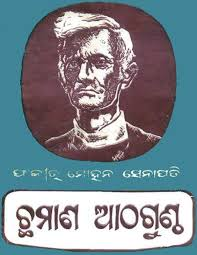 Consider Fakir Mohan Senapati’s enormously sly, satirical and lightfooted novel Six Acres and a Third (1902). The plot of Senapati’s novel revolves around a village landowner’s plot to take over the small landholding of some humble weavers. But this is also the Indian village in the high noon of colonialism, and the first readers of Senapati’s story would have delighted in the many potshots taken by the narrator against new and perplexing British institutions or perverse intellectual fashions, administered and advanced by a new class of English-educated Indians. ‘Ask a new babu his grandfather’s father’s name, and he will hem and haw,’ the narrator chirps, ‘but the names of the ancestors of England’s Charles the Third will readily roll off his tongue.’
Consider Fakir Mohan Senapati’s enormously sly, satirical and lightfooted novel Six Acres and a Third (1902). The plot of Senapati’s novel revolves around a village landowner’s plot to take over the small landholding of some humble weavers. But this is also the Indian village in the high noon of colonialism, and the first readers of Senapati’s story would have delighted in the many potshots taken by the narrator against new and perplexing British institutions or perverse intellectual fashions, administered and advanced by a new class of English-educated Indians. ‘Ask a new babu his grandfather’s father’s name, and he will hem and haw,’ the narrator chirps, ‘but the names of the ancestors of England’s Charles the Third will readily roll off his tongue.’The story appears to be generating, then, an argument about history and about political resistance. India must rid itself of its colonial masters, it seems to say, because they have delegitimised many of the traditional knowledge systems and truths of Indian society, and in the process made the modern Indian self-imitative and inauthentic. (The argument persists in today’s debates about ‘westernisation.’)
But this raises a new question, one that is not lost on Senapati. Was traditional Indian village society itself ever very wise, just, or balanced? As the story progresses, we see that anti-colonial sentiments have not blinded the narrator to the need to subject his own side to the scrutiny of satire. When we hear that ‘The priest was very highly regarded in the village, particularly by the women,’ and that ‘The goddess frequently appeared to him in his dreams and talked to him about everything’ the complacency and mystifications of Brahmanical Hinduism are also laid bare, as is the credulity about those who would place their faith in such a system.
Senapati’s irony is particularly effective because of its double-sidedness, and leads to a point useful as much in our time as his own. That is: criticism of a clearly marked-out ‘other’ (to Indians in the early 20th century, the British; to Hindu nationalists today, Muslims and Christians) often legitimises a sweeping and complacent faith in one’s own worldview; that the search for truth or meaning in history must remain a charade if not accompanied by the capacity for self-criticism. The novel’s argument, buried in its details and never overtly stated, is liberating not because it is comforting or inspiring, but precisely because it is disenchanted. Fiction shows us how human beings are themselves fiction-making creatures, and must therefore take special care to scrutinise what they believe to be foundational truths.
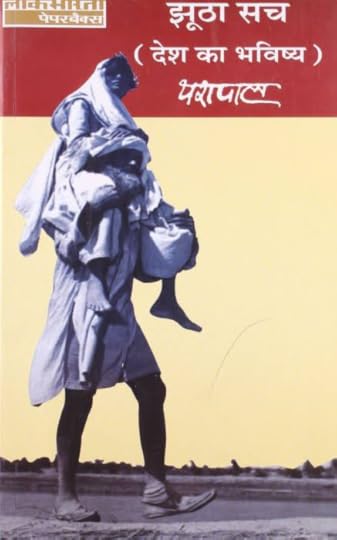 A different kind of novelistic irony—cosmic rather than comic—radiates from This Is Not That Dawn, the English translation of Jhootha Sach, the Hindi novelist Yashpal’s thousand-page novel from the 1950s about Partition. The story tracks the lives and loves of Tara and Jaidev, a pair of siblings, across the worlds of Lahore and New Delhi in the years both before and after Partition. In so doing, Yashpal’s novel generates dozens of alternative views of that cataclysm from viewpoints male and female, Hindu and Muslim, Indian and Pakistani (at the very moment that these new highly charged and adversarial identities are coming into being), prospective and retrospective.
A different kind of novelistic irony—cosmic rather than comic—radiates from This Is Not That Dawn, the English translation of Jhootha Sach, the Hindi novelist Yashpal’s thousand-page novel from the 1950s about Partition. The story tracks the lives and loves of Tara and Jaidev, a pair of siblings, across the worlds of Lahore and New Delhi in the years both before and after Partition. In so doing, Yashpal’s novel generates dozens of alternative views of that cataclysm from viewpoints male and female, Hindu and Muslim, Indian and Pakistani (at the very moment that these new highly charged and adversarial identities are coming into being), prospective and retrospective.Each character’s position or dilemma carries its own distinctive charge of hope, memory, conviction, doubt, naïveté, prejudice, fatalism, cynicism: a vast narrative collage of human beings swimming valiantly with and against the tides of history. If the narrator himself has something to say about the logic or validity of the breaking up of India, it remains parcelled out among the characters, and must be intuited by the reader.
In fact, although the book faces up squarely to the tremendous violence and horror of Partition, the feeling we take away from Yashpal’s novel is not that of an entirely tragic story. Of course, Partition destroyed a particular shared and longstanding, if uncodified, sense of what it meant to be Indian. But as we perceive from the quest of the protagonist, Jaidev Puri, to start his own newspaper rooted firmly in a rejection of religious partisanship of either a Hindu or Muslim stripe, what it means to be Indian would, in a new democratic and secular republic, have entailed building upon a new foundation in any case. At certain junctures in history, the novel shows us, tragedy and moral progress may be inseparably mingled.
As we can now see more than seven decades later, the new Indian republic has faced many challenges in remaining secular (and indeed democratic). Perhaps, in retrospect, we might say that it asked too much of the first citizens of independent India, who might have preferred political independence while remaining wedded to their old ways of social organisation. A splendid insight into the tensions between the hierarchical imperatives of Hinduism and the egalitarian impulses of the new Indian democracy might be found in the novels of the great Kannada novelist UR Ananthamurthy, and nowhere more convincingly so than in his early novel Samskara (1965), published when Ananthamurthy was just 33.
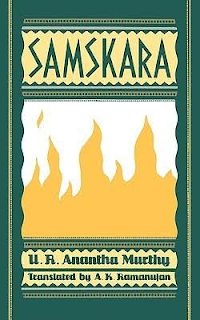 Samskara is, as the title indicates, about rites for the dead. Its plot turns on the dilemma posed by Naranappa, a man even more troublesome dead than alive. Naranappa is a member of a small agrahara, or settlement, of brahmins in rural Karnataka. The brahmins are, for the most part, almost stereotypically true to type: they live off alms and donations, perform rituals for the rest of the community, interpret the sacred books, and uphold through both poetry and penance the values of an ancient (and apparently eternal) hierarchical social order.
Samskara is, as the title indicates, about rites for the dead. Its plot turns on the dilemma posed by Naranappa, a man even more troublesome dead than alive. Naranappa is a member of a small agrahara, or settlement, of brahmins in rural Karnataka. The brahmins are, for the most part, almost stereotypically true to type: they live off alms and donations, perform rituals for the rest of the community, interpret the sacred books, and uphold through both poetry and penance the values of an ancient (and apparently eternal) hierarchical social order.But Naranappa has gone rogue, profaning the tradition, provoking his neighbours with orgies of drinking and meat-eating, living in sin with a woman of a lower caste. There is no taboo he has not traduced. If he has not been excommunicated, it is only because the agrahara’s leader, the wise and compassionate scholar Praneshacharya, has long waged a war to reform his demoniacal nature. When Naranappa suddenly passes away, a question of profound significance comes up, one on which the entire world order seems to turn. Must the dead man be cremated with all the respect due to a high-born Brahmin? Or will the brahmins who survive him themselves be polluted by performing the last rites of someone who devoted himself to ‘kicking away at brahmanism’? It is Praneshacharya who must decide. Confused, the man widely known as ‘the Crest-Jewel of Vedic Learning’ turns to his palm-leaf manuscripts for guidance. What precedents exist for a conundrum such as this?
Upon the horns of this beautifully counterbalanced conflict—dead against the living, hedonism against self-restraint, profaner against pardoner, sexuality against textuality—Ananthamurthy sets down an allegory of Indian history with a particular resonance for the 20th century, and indeed the one after. For although the novel appears to be set in the unchanging Village Time of old India, in actual calendar time we are somewhere in the 1950s, in the levelled world of the new Indian democracy, that has made its touchstone not the books of revelation, but a constitution thrashed out by human beings.
Slowly, our view of the dead man’s misdemeanours changes colour. Perhaps Naranappa, underneath the obvious provocation of his saturnalia, represents the spirit of the new freedom, blowing away the fossilised thinking sanctified by the centuries. In openly falling in love and living with a low-caste woman, Naranappa shows a greater humanity than that required merely by ‘keeping the faith.’ Unlike his compatriots, flapping cantankerously in manacles of jealousy and moralism, he thinks on his feet and with his body.
Even the spotless Praneshacharya finds himself morally discombobulated by the age: his righteousness is founded upon a deep social conservatism, and he thinks through the foundational categories of purity and pollution, which find no place in the new social compact. The brahmins, we see, are prisoners of history, huddled in a cocoon of hypocritical piety; never daring to live beyond the ‘duties a brahmin is born to.’ Teaching all other castes to keep their own boundaries, they preside over a sterile society, when the age demands a new moral creativity. When they face a dilemma, they delve into their palm-leaf manuscripts, not into themselves. Praneshacharya begins to perceive this, but is powerless to act upon his intuition. Until his body does. On a trip deep into the forest to seek out an answer at the feet of a god, he encounters Naranappa’s voluptuous companion and ends up sleeping with her.
Now Praneshacharya, too, is a sinner, forced to confront his own repressed carnality. ‘I suddenly turned in the dark of the forest,’ he ruminates. Smarting with shame but rapt with a strange exhilaration, he takes to the road, both running away from himself and in search of himself. Ananthamurthy’s finespun prose, rendered in exquisite cadences by his late translator AK Ramanujan, tracks with great rigor the inner monologue of Praneshacharya as he arrives a new vision of the self. And as we follow Praneshacharya there, we see that we have reached a point not just metaphysical but metafictional. In place of the Sacred Books, perhaps it is the novel that contains the wisdom and the doubt that India needs for a new age in its history (which would make Ananthamurthy a kind of novelistic Naranappa). It’s a startling story, one as provocative for its time and place as those of Cervantes, Sterne and Diderot must have been in theirs.
As these examples show, the work of novels is not confined to mere representation of historical realities (although this is where they may start). Rather, a novel may be a creative intervention in history in its own right—an actual agent of history, passing on to the reader who passes through its narrative field both its diagnostic powers and visionary charge. Indeed, from Bibhutibhushan Bandyopadhyay to UR Ananthamurthy, Bankimchandra Chatterjee to Kiran Nagarkar, Qurratulain Hyder to Salma, Phanishwarnath Renu to Amitav Ghosh, novelists have generated some of the most layered and sophisticated visions of Indian history produced in the last two centuries. Yet as a group they fall into no school or political camp—some of them possess a conservative rather than progressive sensibility. What unites them is their interpretative power and their ability to illuminate and complicate the particular historical crux they focus on.
It would appear that there is something inherent in the novel form—the persuasive power and freedom of a story when compared to a discursive argument; the prospect of linking the world of the self with that of the community and society; the freedom to rove in spaces of the past that we cannot access by means other than that of the imagination; the potential to think dialectically in exchanges between characters or switches in perspective between the narrator and the characters—that makes the space of the novel a particularly fertile ground for historical thinking.
And when they are themselves reinserted into the canvas of Indian history, it seems to me that the projects of the Indian novel and that of Indian democracy (both fairly new forms in Indian history) appear uncannily similar—and perhaps similarly unfinished. As Indian democracy has over the last seven decades sought to fashion a new social contract in a deeply hierarchical civilisation, so the great Indian novel has attempted not just to address but also to form a new kind of reader/citizen, alive to both the iniquities and the redemptive potential of Indian history.
January 9, 2023
Mahatma Gandhi and the Art of Travel
On January 9, 1915, a lawyer and community organiser from Gujarat called Mohandas Karamchand Gandhi (at 46, already in late middle age) stepped off the ship SS Arabia at Bombay Harbour. Gandhi had spent the previous two decades in South Africa, where he had made a name for himself representing the civil cases of the prosperous merchants of Indian origin there and the struggle for political rights of indentured labourers of Indian origin in a society divided on racial lines. Before that, he had also spent a few years as a (fairly mediocre) student in England.
In between these two stints abroad, Gandhi had already made one brief, unsuccessful attempt in the 1890s to return to India and set up his own legal practice. One reason for his failure then was his own diffidence; another, the fact that, as an Indian who had travelled abroad across the “black waters”, he was seen as having lost caste in a highly stratified and cloistered social world. Indians of that time preferred to deal with somebody uncorrupted by contact with the great unknown.
Though he returned to India a successful and even wealthy man, Gandhi’s travels had not made him arrogant, but rather more curious and more humble, even at the age of 46. It’s worth noting that he had promised his political mentor, Gopal Krishna Gokhale, that he would not speak or write on India for a year, till he had travelled around the country and acquainted himself with its problems.
During his sojourn in South Africa, Gandhi had discovered something enormously liberating about the life of émigrés. The boundaries drawn by Indians at home between themselves were blurred, and sometimes entirely abandoned, by the solidarities and hardships of being Indians abroad – which experience, for the rest of his lifetime, was to be expressed in Gandhi’s optimism about the ability of Indians to transcend their differences and work together.
Gandhi’s early life in Gujarat, then, and his outlook as a devout Hindu, were orthodox; his life experience for an Indian of the time, unusually heterodox. Among the protagonist in the movement for Indian independence (which he transformed within a decade from a primarily upper-class, small-scale campaign to a mass movement), no one possessed a sophisticated sense of the possibilities and civilizational blind spots of both India and the West – or such a willingness to turn the harsh light of criticism upon his own country (and indeed himself).
Through his capacity to combine homegrown ideas with those from around the world, Gandhi forged, first abroad and then at home, a creative new political philosophy called “satyagraha”, or “truth-force” – a compound of nonviolence, active resistance, and demanding self-scrutiny that was to become part of the basic vocabulary of modern political resistance. He came to it by way of the theories of Tolstoy and Ruskin, as also the Bhagavad Gita. To this day, Gandhi's thought holds a prominent place in the world’s sense of what it means to be Indian (even if its ideals are today under siege in India itself).
South Africa, as many have argued, was the making of Gandhi. The scholar Judith Brown put it well when she wrote, “Gandhi's twenty years in South Africa were not just his apprenticeship as a political mobilizer. They also provided the time and circumstances in which he formulated his attitude to India and the West; and this, far more than his political capacity and experience, was to mark him out on his return to India.”
One might even say Gandhi's travels had ennobled him. Having fought for the cause of Indians in South Africa, many of them Muslim, he could not bring himself to divide Indian society reflexively into Hindus and Muslims, as so many of his companions in the independence movement did explicitly or privately. He sought an independent Indian nation-state that would be home to all the faiths of the subcontinent.
Having grown up reflexively obeying the codes of Hindu social life – including marriage to a child bride – Gandhi returned to India transformed by his experiments in thought and morality. From now on (as we see in his autobiography, one of the twentieth century’s greatest books), he was determined to move the giant edifice of Hinduism back in dialogue – and if necessary in conflict – with the call of the individual conscience. He was eventually to pay the price for this with his life.
What can Indians today learn from Gandhi’s attitude to travel? From the time of Gandhi’s return to India onwards, a great change has come about in the size and character of the Indian diaspora. Indians began to leave the country in ever-greater numbers, on terms more amenable than those of indentured labour; no longer were they resented for their departure, or rejected on their return.
Everywhere they went, they came together to form small replicas of the beloved world they had left behind. Some lapsed into conservatism, nostalgia and a partitioned mental life, while others, like Gandhi, embraced the challenge of refashioning many of their values and beliefs in the light of their new experiences–and often brought the results home.
The story of the homecoming, more than a hundred years ago, of the greatest overseas Indian in history makes for an eternally resonant parable. As Gandhi proved, sometimes the best way of knowing oneself and one’s civilization is by going away.
A version of this piece was first published in Bloomberg Opinion.
Mahatma Gandhi and the meaning of being a Pravasi Bharatiya
Today, January 9, marks the anniversary of the greatest homecoming ever by an Indian, one now celebrated in India – the mother country of perhaps the largest and most farflung diaspora in the world – as Pravasi Bharatiya Divas, or “Overseas Indian Day”.
On January 9, 1915, a lawyer and community organiser from Gujarat called Mohandas Karamchand Gandhi (at 46, already in late middle age) stepped off the ship SS Arabia at Bombay Harbour. Gandhi had spent the previous two decades in South Africa, where he had made a name for himself representing the civil cases of the prosperous merchants of Indian origin there and the struggle for political rights of indentured labourers of Indian origin in a society divided on racial lines. Before that, he had also spent a few years as a (fairly mediocre) student in England.
In between these two stints abroad, Gandhi had already made one brief, unsuccessful attempt in the 1890s to return to India and set up his own legal practice. One reason for his failure then was his own diffidence; another, the fact that, as an Indian who had travelled abroad across the “black waters”, he was seen as having lost caste in a highly stratified and cloistered social world. Indians of that time preferred to deal with somebody uncorrupted by contact with the great unknown.
Though he returned to India a successful and even wealthy man, Gandhi’s travels had not made him arrogant, but rather more curious and more humble, even at the age of 46. It’s worth noting that he had promised his political mentor, Gopal Krishna Gokhale, that he would not speak or write on India for a year, till he had travelled around the country and acquainted himself with its problems.
During his sojourn in South Africa, Gandhi had discovered something enormously liberating about the life of émigrés. The boundaries drawn by Indians at home between themselves were blurred, and sometimes entirely abandoned, by the solidarities and hardships of being Indians abroad – which experience, for the rest of his lifetime, was to be expressed in Gandhi’s optimism about the ability of Indians to transcend their differences and work together.
Gandhi’s early life in Gujarat, then, and his outlook as a devout Hindu, were orthodox; his life experience for an Indian of the time, unusually heterodox. Among the protagonist in the movement for Indian independence (which he transformed within a decade from a primarily upper-class, small-scale campaign to a mass movement), no one possessed a sophisticated sense of the possibilities and civilizational blind spots of both India and the West – or such a willingness to turn the harsh light of criticism upon his own country (and indeed himself).
Through his capacity to combine homegrown ideas with those from around the world, Gandhi forged, first abroad and then at home, a creative new political philosophy called “satyagraha”, or “truth-force” – a compound of nonviolence, active resistance, and demanding self-scrutiny that was to become part of the basic vocabulary of modern political resistance. He came to it by way of the theories of Tolstoy and Ruskin, as also the Bhagavad Gita. To this day, Gandhi's thought holds a prominent place in the world’s sense of what it means to be Indian (even if its ideals are today under siege in India itself).
South Africa, as many have argued, was the making of Gandhi. The scholar Judith Brown put it well when she wrote, “Gandhi's twenty years in South Africa were not just his apprenticeship as a political mobilizer. They also provided the time and circumstances in which he formulated his attitude to India and the West; and this, far more than his political capacity and experience, was to mark him out on his return to India.”
One might even say Gandhi's travels had ennobled him. Having fought for the cause of Indians in South Africa, many of them Muslim, he could not bring himself to divide Indian society reflexively into Hindus and Muslims, as so many of his companions in the independence movement did explicitly or privately. He sought an independent Indian nation-state that would be home to all the faiths of the subcontinent.
Having grown up reflexively obeying the codes of Hindu social life – including marriage to a child bride – Gandhi returned to India transformed by his experiments in thought and morality. From now on (as we see in his autobiography, one of the twentieth century’s greatest books), he was determined to move the giant edifice of Hinduism back in dialogue – and if necessary in conflict – with the call of the individual conscience. He was eventually to pay the price for this with his life.
What can Indians today learn from Gandhi’s attitude to travel? From the time of Gandhi’s return to India onwards, a great change has come about in the size and character of the Indian diaspora. Indians began to leave the country in ever-greater numbers, on terms more amenable than those of indentured labour; no longer were they resented for their departure, or rejected on their return.
Everywhere they went, they came together to form small replicas of the beloved world they had left behind. Some lapsed into conservatism, nostalgia and a partitioned mental life, while others, like Gandhi, embraced the challenge of refashioning many of their values and beliefs in the light of their new experiences–and often brought the results home.
The story of the homecoming, more than a hundred years ago, of the greatest overseas Indian in history makes for an eternally resonant parable. As Gandhi proved, sometimes the best way of knowing oneself and one’s civilization is by going away.
A version of this piece was first published in Bloomberg Opinion.
Chandrahas Choudhury's Blog
- Chandrahas Choudhury's profile
- 25 followers



